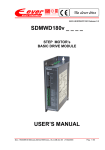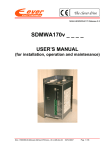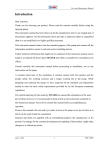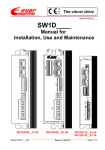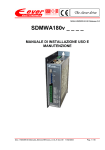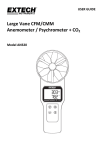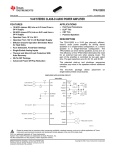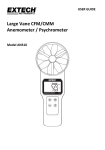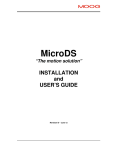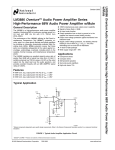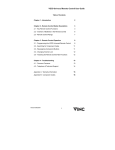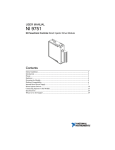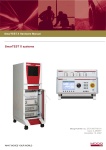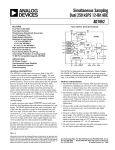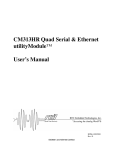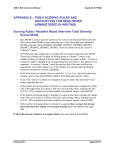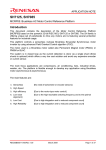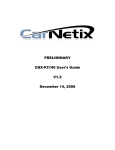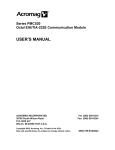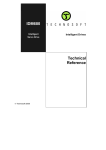Download SDMWD170v _ _ _ _ USER`S MANUAL
Transcript
The clever drive MAN.HESDMWD170 Release 0.2 SDMWD170v _ _ _ _ STEP MOTOR’s BASIC DRIVE MODULE USER’S MANUAL Doc.: HD0380-00-Manual_Sdmwd170Vxxxx_r.0.2_GB.doc-02 24/02/2003 Pag. 1 / 62 IMPORTANT NOTICE This document is copyrighted by EVER Company. It is supplied to the user with the understanding that it will mot be reproduced, duplicated, or disclosed in whole or in part without the express written permission of EVER Company. EVER co. reserves the right to make changes without further notice to any products herein to improve reliability, function or design without warning or the obligation of adjournment of the manufactures and preceding handbooks. EVER co. does not assume any liability arising out of the application or use of any product or circuit described herein. EVER Elettronica VIA DEL Commercio , 2/4 Loc. S. Grato Z.I. 26900 – LODI - ITALY Tel. ++39(0)371412318 Fax ++39(0)371412367 E-mail: [email protected] Web: www.everelettronica.com EVER Elettronica Technologiezentrum – Europaplatz D – 52068 Aachen – GERMANY Tel. ++49(0)2419631836 Fax ++49(0)2419631835 Ver. Verify 0.1 0.2 0.3 Approval FA Printed in LODI - ITALY Date 24/02/2003 Doc.: HD0380-00-Manual_Sdmwd170Vxxxx_r.0.2_GB.doc-02 24/02/2003 Pag. 2 / 62 SDMWD170 INDEX 1 INTRODUCTION..............................................................................................................5 1.1 Driving system parts....................................................................................................5 1.2 SDMWD170 description..............................................................................................6 1.3 Basic Drive block diagram...........................................................................................6 1.4 Drive use limits, risks and warnings ............................................................................7 1.5 Warranty......................................................................................................................8 1.6 In this manual..............................................................................................................9 2 Specifications.................................................................................................................10 2.1 Mechanical.........................................................................................................10 2.2 Electrical ............................................................................................................11 2.2.1 Power supply ratings..........................................................................................11 2.2.2 I/O electrical specifications ................................................................................11 2.2.3 CAN Bus interface .............................................................................................19 2.2.4 RS232 and RS485 interface ..............................................................................20 3 DRIVE INSTALLATION..................................................................................................21 3.1 Unpacking, Inspecting and Storing ...........................................................................21 3.2 Selecting Motors and Options ...................................................................................21 3.3 User adjustments: Dip-switch settings ......................................................................22 3.4 Installing and Using the Unit Safely ..........................................................................23 3.5 Mounting the Drive ....................................................................................................24 3.6 Connecting to the Drive.............................................................................................26 3.6.1 CN5: Connecting to Earth Ground (EG)....................................................................28 3.6.2 CN5: DC Supply Input (PS).......................................................................................29 3.6.3 CN6: Connecting to Stepper Motor Output (SM).......................................................31 3.6.4 CN3 – CN13: Connecting to drive Inputs ..................................................................33 3.6.5 CN4: Connecting to drive Outputs ............................................................................34 3.6.6 CN2: Connecting to the drive Analog Inputs .............................................................36 3.6.7 CN1: Connecting to CANbus ....................................................................................38 3.6.8 CN1 - CN11: Connecting to RS232 and RS485 interfaces.......................................40 4 STARTING THE SDMWD170 DRIVE............................................................................42 4.1 Testing the Installation ..............................................................................................42 4.2 Maintaining.........................................................................................................42 4.3 Drive operating condition monitoring .................................................................43 4.3.1 Troubleshooting Table .......................................................................................47 5 SDMWD170 VERSIONS AND SPECIFICATIONS .......................................................49 5.1 Drive Coding and Ordering Information ....................................................................49 5.2 Table of SDMWD170Vxxxx available versions .........................................................49 5.3 SDMWD170vB221 Basic Drive (C0300)...................................................................50 5.3.1 Electrical specifications......................................................................................50 5.3.2 Dip switch settings .............................................................................................52 5.4 SDMWD170vB231 Basic Drive (C0400)...................................................................54 5.4.1 Electrical specifications......................................................................................54 5.4.2 Dip switch settings .............................................................................................56 A.1 Factory and user dip-switch setting...........................................................................58 A.2 Power Supply ............................................................................................................60 Doc.: HD0380-00-Manual_Sdmwd170Vxxxx_r.0.2_GB.doc-02 24/02/2003 Pag. 3 / 62 User Notes : Doc.: HD0380-00-Manual_Sdmwd170Vxxxx_r.0.2_GB.doc-02 24/02/2003 Pag. 4 / 62 1 INTRODUCTION This section 1.1 introduces the main characteristics of the SDMWD170Vxxxx drive as a part of a step motor driving system. Driving system parts Parts to provide a stepper with for motion system completion Block diagram Master Unit Stepper Drive AC/DC Power Supply Stepper Motor Load Motion system design steps: 1. Driving requirements definition (load torque, RPM, positioning precision, acceleration an d speed ratings, etc.); 2. Motor selection according to the previous step ratings; 3. Drive characteristics selection to meet: a. Motor power ratings b. Motion control commands mastering (Step / direction, serial communication links, etc.) c. Additional features (User I/O, encoder interface, etc.) 4. DC power supply sizing according to motion profile, motor power, drive supply ratings; 5. Drive heat dissipation capability provision; Sizing tools i Refer to [email protected] service for system parts sizing (motor, drive and power supply). Refer to section A.2 for optional cooling devices. Refer to section A.2 for power supply sizing information. Doc.: HD0380-00-Manual_Sdmwd170Vxxxx_r.0.2_GB.doc-02 24/02/2003 Pag. 5 / 62 1.2 SDMWD170 description The SDMWD170 has been designed to drive a step motor in 2 phases on bipolar chopper mode through step/direction inputs. The basic drive is compliant with the EN61800-3 and 60204-1 standards. The additional steps user must take to ensure a complete compliance are: earth connection of drive and motor, proper installation, ac mains filter, EMC compliant cabling of motor and drive. 1.3 Basic Drive block diagram The figure in the following shows the block diagram of a SDMWD170Vxxxx unit: a step & direction controlled device that can drive a two-phase motor in the bipolar chopper mode. The motor can have 4, 6 or 8 leads as well. Thanks to the output stages voltage and current ratings, a wide range of motors can be driven by the drive. Motor features must be compatible with the output ratings of the drive. The drive is provided with: • Micro-stepping for high resolution and smooth stepper operation; • Winding current waveforms sinusoidal shaping to optimize motor performances; • Over/Under voltage, Thermal and Over Current protections, with monitoring, to prevent the electronics from damaging. • Motor steps ramps generation capability 1 MECHANICAL PARTS 1kV Power Supply DC/DC SUPPLY DC EG PROTECTION CIRCUITRY OPTO ISOLATION OPTO ISOLATION MEG “A” BRIDGE SM “B” BRIDGE Step Motor 1 i CONTROL LOGIC DIP SWITCH Master Unit I/O Serial link D I S P L A Y Max electric strength voltages between drive’s parts This manual contains mainly information and procedures to install, set-up and troubleshoot the unit. Several functions of the device depend on the version of the same. Doc.: HD0380-00-Manual_Sdmwd170Vxxxx_r.0.2_GB.doc-02 24/02/2003 Pag. 6 / 62 1.4 Drive use limits, risks and warnings - The planning of the installation must be compliant with the prescriptions in this manual. - EVER ELETTRONICA is in no way responsible for damages to persons or to things caused by an improper use of the equipment. - The system is actually an internal part of switchboard: it is responsibility of the planner of the SDMWD170 installation to meet a proper working environment providing at least the essential duty of the current standard. - This manual is only for the planner of the SDLWD170 installation and not like support documentation for user. Attention Only qualified Electro-personnel Danger Hazardous Voltages Hot Surfaces The installation of the unit as well as of the accessories is only permissible by qualified personnel. A safe and trouble-free operation is only possible when the valid regulations according to EN 60204-1, EN61800-3 as well as the relevant regulations for end user’s area are observed. The opening of the drive’s external enclosure is forbidden: inside it there are parts at high temperature. After any working section, wait some minutes before operating on the device so that the temperature of heat sink and the capacitors voltage go down to not dangerous values. Pay attention to the DC supply and motor cables connections: when the motor connector is unplugged and the SDMWD170 is powered dangerous voltages can be present on motor connector pins. Making high pot tests on a machine including the SDMWD170 drive, be sure not to exceed the maximum insulation ratings of the unit. i The unit can cause surrounding pollution if removal standard requirements are not met at casting off. Doc.: HD0380-00-Manual_Sdmwd170Vxxxx_r.0.2_GB.doc-02 24/02/2003 Pag. 7 / 62 1.5 Warranty Ever Electronica warrants its motors and controllers to the original purchaser (end users, original equipment manufacturers or distributors), to be free from defects in material and workmanship and to be made in accordance with customer’s specifications which have been accepted in writing with Ever. Ever Elettronica’s products are warranted for one year from date of manufacture as determined by the date code on the drive label. In no event, however, shall EVER be liable or have any responsibility under such warranty if the product has been improperly stored, installed, used or maintained, or if the customer allows any unauthorized modifications, adjustment and/or repairs to such product. EVER's obligation hereunder is limited solely to repairing ( or replacing at its option), at its factory any product, or parts, which prove to EVER's satisfaction to be defective as a result of defective materials or workmanship, in accordance whit EVER's stated warranty. The contents of this manual are believed to be correct at the time of printing. To allow continuous development and improvement of manufactures, EVER co. reserves the right to change the specifications, characteristics and performances of the product and the contents of this manual without notice. EVER co. does not recommend the use of its products in life support applications wherein a failure or malfunction of the products may directly threaten life or injury. The user of EVER co. products in life support applications assumes all risks of such use and indemnifies EVER co. against all damages. Doc.: HD0380-00-Manual_Sdmwd170Vxxxx_r.0.2_GB.doc-02 24/02/2003 Pag. 8 / 62 1.6 In this manual The icons used in this Manual have the following meanings: i Danger Warning Caution Used when life or health of the user are exposed to danger or when severe damage to materials can occur. Attention Special instruction for a safe and trouble-free operation. Tip Help Information Used to mark additional important information. An essential element to meet the limit values specified in the EMC directives is, apart from the use of filters and chokes, the installation of the device following the EMC standards requirements. EMC Doc.: HD0380-00-Manual_Sdmwd170Vxxxx_r.0.2_GB.doc-02 24/02/2003 Pag. 9 / 62 2 Specifications 2.1 Mechanical Dimensions Unit: mm “A” mounting style i “B” mounting style As drive mounting parts the user must be provided with: • • • • • • • • • • • • • • #2 or #4 MA4 screws for unit A or B mounting style; #1 5-pins 721-605/000-042 WAGO 5mm pitch setting male connector for motor connection; #1 4-pins 721-104/026-045 WAGO 5mm pitch setting female connector for power supply and earth ground connection; #1 9-pins 1881396 PHOENIX MICRO-COMBICON 2.5mm pitch setting female connector for Digital Inputs connection; #1 10-pins 11881406 PHOENIX MICRO-COMBICON 2.5mm pitch setting female connector for Digital Outputs connection; #1 4-pins 1881341 PHOENIX MICRO-COMBICON 2.5mm pitch setting female connector for Digital Outputs connection; #1 SubD 9-pins female connector for serial link Dimensions 175(H) x 47.7(W) x 124(D) mm Weight 1500 g Protection class IP 20 Storage temperature from - 25° C to +55° C Operating ambient temperature from 5 to 50° C Humidity 5% to 85% not condensing Maximum working altitude 1000 m. Doc.: HD0380-00-Manual_Sdmwd170Vxxxx_r.0.2_GB.doc-02 24/02/2003 Pag. 10 / 62 2.2 i Electrical The electrical specifications tolerances, when not differently indicated, are according to EN 60204 standard requirements. Some ratings depend on the actual drive version. 2.2.1 Power supply ratings Refer to section 5.0 for the electrical specifications and voltage ratings of power supply of the actual drive version. 2.2.2 I/O electrical specifications Digital Inputs can be used as real time, opto-isolated, 200kHz, 5Vdc line driver and 24Vdc PNP/Push-Pull type. Digtal inputs cannot work at the same time as 5Vdc or 24Vdc Digital Inputs Schematic 1 2 +Input R1 R2 DZ VCC R3 2 -Input D1 4 R4 COM_IN GND User I/O: +Input vs COM_IN => 24Vdc input +Input vs -Input => 5Vdc Line-Driver Ratings 3 The line driver inputs are designed to be driven through devices having the following V-A output characteristic. Vod - output differential Voltage 4,5 DS26LS31CN 4 Vod/0°C 3,5 Vod/25°C 3 Vod/75°C 2,5 100ohm 2 1,5 0 5 10 15 20 25 30 35 40 45 50 Io – output current - mA Doc.: HD0380-00-Manual_Sdmwd170Vxxxx_r.0.2_GB.doc-02 24/02/2003 Pag. 11 / 62 To prevent input circuitry from improper functioning and damaging do not exceed the inputs maximum ratings listed in the following table. Digital Input Rated Voltage Limits Max. Min. Max. 24 Vdc ± 20% Min. fMAX Protection 5 Vdc ± 5% i State 0 State 1 UL IL UH IH V mA V mA 1.5 ND 5 17 0 ND 2 3 ND ND 19.2 7 ND ND 28.8 12 200kHz Against wrong control voltage polarity The devices connected to the drive inputs must be powered through a dedicated power supply. Inputs Electrical Driving Guidelines Inputs controlling devices with an output voltage Vo (Volt) exceeding the Line Driver's ratings must be connected to the basic drive inputs through a series resistor Rs rated the following way (Vo is assumed greater than 10 Vdc): RS = [Vo * 125 – 220] Ω with a power rating 2 PD = [(Vo / (RS + 220)) * RS ] W For instance: Assuming Vcc = 24Vdc ± 15% RS = (24 * 125) - 220 ≈ 2780 Ω 2 PD = (24 / (2700 + 220)) * 2700 ≈ 0.18W (0.25W @ Vo+15%) A 2.7kΩ - ½ W rated external series resistor can be a proper choice. Assuming Vcc = 12Vdc ± 15% RS = (12 * 125) - 220 ≈ 1280 Ω 2 PD = (12 / (1200 + 220)) * 1200 ≈ 0.086W (0.12W @ Vo+15%) A 1.2kΩ - ½ W rated external series resistor can be an effective choice Doc.: HD0380-00-Manual_Sdmwd170Vxxxx_r.0.2_GB.doc-02 24/02/2003 Pag. 12 / 62 Connection guidelines versus input driving device output style. PNP source VCC = 5 Vdc VCC PNP source BD Input Rs R1 CNx.x 2 R2 1 DZ User device VCC R3 2 CNx.x D1 4 R4 COM_IN GND 3 VCC = 24 Vdc VCC BD Input PNP source CNx.x R1 2 R2 1 DZ User device VCC R3 2 CNx.x D1 COM_IN R4 4 GND 3 Doc.: HD0380-00-Manual_Sdmwd170Vxxxx_r.0.2_GB.doc-02 24/02/2003 Pag. 13 / 62 NPN sink VCC = 5 Vdc VCC BD Input R1 CNx.x R2 2 User device 1 DZ Rs NPN sink VCC R3 2 CNx.x D1 4 R4 COM_IN GND 3 Push-Pull sink VCC = 5 Vdc VCC BD Input CNx.x R1 2 R2 1 DZ Push-pull sink Rs VCC R3 2 CNx.x D1 COM_IN User device Doc.: HD0380-00-Manual_Sdmwd170Vxxxx_r.0.2_GB.doc-02 24/02/2003 R4 4 GND 3 Pag. 14 / 62 Push-Pull source VCC = 5 Vdc VCC BD Input Rs R1 CNx.x R2 1 DZ Push-pull source VCC R3 2 CNx.x User device D1 4 R4 COM_IN GND 3 VCC = 24 Vdc VCC BD Input CNx.x R1 R2 1 DZ Push-pull source 2 CNx.x User device VCC R3 D1 COM_IN R4 4 GND 3 Doc.: HD0380-00-Manual_Sdmwd170Vxxxx_r.0.2_GB.doc-02 24/02/2003 Pag. 15 / 62 Push-pull sink-source VCC = 5 Vdc VCC Complementary Push-pull (Sink Source) BD Input User device CN1.x R1 2 R2 1 DZ VCC R3 VCC 2 CN1.x 4 1 2 D1 COM_IN GND R4 3 - Line-Driver differential 5 Vdc Line driver Differential BD Input 3 CN1.x 2 R1 2 R2 1 DZ 2 CN1.x D1 User device VCC R3 COM_IN R4 4 GND 3 Doc.: HD0380-00-Manual_Sdmwd170Vxxxx_r.0.2_GB.doc-02 24/02/2003 Pag. 16 / 62 Digital Outputs are optoisolated, short circuit protected, 24Vdc PNP type. Output electrical specification In (A) 0.5 Rated current (state 1) Max (A) 0.7 Max current (state 1) Max current for output Iout(A) 0,5@24Vdc with 4 output ON N° max output ON at N° 4 max current Max (V) 3 Voltage drop (state 1) Max (A) 2 Leakage current (state 0) Vnom 24Vdc Rated voltage Vmin 19Vdc Min voltage output Vmax 28.8Vdc Max voltage output Vrmax 1Vdc Max voltage ripple PNP current source Type f 1kHz Max frequency output Short circuit between OUT and GROUND, between OUT and +V, between OUT and Protection OUT, Open Load Detection Overload & short circuit > 0.7A min I (over-current) = 2.5A max threshold protection 100µs Protection intervention tshortMAX @Vout = 30Vdc delay @RL = 0 1 3 2 4 CN4 Output driver Doc.: HD0380-00-Manual_Sdmwd170Vxxxx_r.0.2_GB.doc-02 24/02/2003 Pag. 17 / 62 Analog Inputs +/-10Vdc CEI EN 61131-2 type, not isolated. CEI EN 61131-2 compliant analog inputs ±10Vdc Input voltage range ≥10Kohm Input impedance limits 19.5mV (1024) 10 bit Reading resolution Maximum error over full ± 3% of full range temperature range Vin = 57Vdc Maximum overload Imax = 2mA Digital output reading under 1024 overload condition Differential not isolated Type of input TSAMPLE = 1ms Input sampling time T=1ms Sampling repetition time 1° order Input filtering characteristics Transition frequency: Hz –[email protected] Resistor-diode and ricirculating network Protection type Sample & Hold Conversion method Self-scan Operating mode Analog Inputs schematic VCC VCC INAN INAN + Doc.: HD0380-00-Manual_Sdmwd170Vxxxx_r.0.2_GB.doc-02 24/02/2003 Pag. 18 / 62 2.2.3 CAN Bus interface Introduction i The CAN Bus interface provides a multipoint connection according to the ISO 11898 standard. The isolated interface is powered by an internal isolated DC/DC converter, no external power supply is required. Refer to section 5 for information about available device’s versions. Refer to software manual for information about the can bus interface operating modes. Network connection style MASTER UNIT SDMWD SDMWD SDMWD 2 3 n-1 SDMWD I 1 n d L Doc.: HD0380-00-Manual_Sdmwd170Vxxxx_r.0.2_GB.doc-02 24/02/2003 Pag. 19 / 62 Network paths length Value Path Notation Unit Condition Min. Nom. Max. Bus L m 0 40 Cable stub I m 0 0.3 Node distance d m 0.1 40 Bit rate: 1Mbit/sec Max baudrate [kbit/s] vs bus length 500 < 100 m 250 < 250 m 125 < 500 m 50 < 1000 m 20 < 2500 m 2.2.4 RS232 and RS485 interface Introduction i i The RS232 interface provide a point to point connection and the RS485 a multipoint connection (RS485) link according to the EIA/TIA232E CCIT V.28 and RS-485 CCITT V.11 X.27 international standards. The isolated interface is powered by an internal isolated DC/DC converter, no external power supply is required. Refer to section 5 for more information about available device’s versions. Refer to software manual for information about the serial interfaces operating modes. 2 Cable Use 0.5 mm² (#20 AWG) or 0.25mm (#23AWG) cross requirements section leads for the RS232 and RS485 paths cabling. Doc.: HD0380-00-Manual_Sdmwd170Vxxxx_r.0.2_GB.doc-02 24/02/2003 Pag. 20 / 62 3 DRIVE INSTALLATION This section i explains how to install the step motor drive. Covered topics are: • • • • • • Unpacking and inspecting the furnishings; Selecting motor and optional drive’s parts; Setting user’s adjustments; Installing and using the unit safely; Mounting the drive; Connecting to the drive. Refer to system diagram in section 1.3. 3.1 Unpacking, Inspecting and Storing Check the item(s) against the packing-list. A label located on the drive’s housing identifies the unit by model version, serial number and manufacture date. Inspect the unit: any transportation damages must be submitted by the buyer to the carrier. Store 3.2 the SDMWD170 unit in a place meeting the specified conditions. Selecting Motors and Options Selecting a motor The SDMWD170 drive is designed for use with EVER’s line of step motors or most other brands two phases step motors. The motor’s ratings must be compatible with the output configuration and ratings of the drive. Refer to the Torque/Speed Curves in the “EVER ELETTRONICA Motors Catalogues” or call EVER sales dept. or your local distributor for motor sizing and drivemotor compatibility planning. Selecting Options Refer to “EVER ELETTRONICA Drives Catalogue” for drive options planning or call EVER Co. sales dept. or refer to www.everelettronica.it Doc.: HD0380-00-Manual_Sdmwd170Vxxxx_r.0.2_GB.doc-02 24/02/2003 Pag. 21 / 62 3.3 User adjustments: Dip-switch settings Dip-switch Location DIP1 and DIP2 are for user adjustments as for instance: - Bus node identification - Baud rate setting - User functioning modes setting DIP2 ON 1 D1 2 D2 3 D3 4 D4 1 2 D1 D2 3 D3 4 D4 5 D5 6 D6 7 D7 8 D8 DIP1 Some parts inside the SDMWD170 housing can be a potential source of electric shock. To avoid electric shock, prior to DIP-SWITCH handling, switch power off and wait until all the leds of 7 segment display on drive front panel are off. i Refer to section 5 for dip-switch function tables in your unit version. Doc.: HD0380-00-Manual_Sdmwd170Vxxxx_r.0.2_GB.doc-02 24/02/2003 Pag. 22 / 62 3.4 Installing and Using the Unit Safely Guidelines Only qualified personnel should install the SDMWD170 unit, after first completely reading and understanding the information in this manual. The installation instructions should be followed and approved. Any question or doubt should be clarified with the supplier of the drive before its use. i In no event will EVER co. accept liability for indirect or consequential damage and consequences resulting from inappropriate, negligent or incorrect installation or modification of the drive or from any incorrect connection to the SDMWD170 drive. The power supply cables, the motor output cables and some parts of the SDMWD170 unit are a potential source of severe electric shock. Follow the safety guidelines to avoid danger. To avoid possible personal injury whenever you are working with SDMWD170 unit: Do not operate the drive without the motor case and the system enclosure connected to ground; The protective earth (PE) impedance must conform to the requirements of local regulations; Do not make any connections to the system internal circuitry; Always turn power supply off before making or removing connections from the unit; When the power supply fails the drive cannot hold the load: do not use system if that can result in a dangerous situation; provide the motor with a suitable blocking device if necessary. Before handling or operating maintenance actions on the SDMWD170 unit, be sure the power supply has been switched off. • Be careful of the motor connector terminals when disconnected from the motor. With the motor disconnected and power applied to the unit, these terminals can have high voltage rise. • Do not use software working program stop as safety shutdown. Always remove power from the drive for a safe shutdown. • Take into account the heat dissipation of some parts the SDMWD170 unit: using the device in heavy application, some enclosure surfaces can have high temperature rise. Before unplugging the drive from the installation wait a proper time for its cooling. Doc.: HD0380-00-Manual_Sdmwd170Vxxxx_r.0.2_GB.doc-02 24/02/2003 Pag. 23 / 62 3.5 Mounting the Drive Environment The drive should be installed in dust, corrosive vapors, gases and liquids free environment. Avoid environments allowing condensation of vaporized liquids, including atmospheric moisture. Installing the drive inside a cabinet, be sure that the air flow openings or the cabinet cooling system do not allow the internal temperature rise to exceed the maximum ambient temperature ratings of the device. Besides above topics any local safety regulations concerning the installation of motor drives has to be carefully considered while planning the location of the drive. Mounting Guidelines Your installation should at least meet the following general guidelines: • Keep vertical orientation of the device; • Avoid excessive vibration or shock; • Provide some free space for air flow below and above the housing. Cooling The SDMWD170 unit has surfaces providing the cooling of the internal circuitry through their heat dissipation capability. Optimize the thermal flow between the unit cooling surfaces and the ambient according to the 'worst case’ power dissipated in your application. Dissipation through the fixing surface Dissipation through a forced air flow SDMWD170 Cooling surfaces SDMWD170 Cooling surfaces Electrical cabinet rear panel Electrical cabinet rear panel Doc.: HD0380-00-Manual_Sdmwd170Vxxxx_r.0.2_GB.doc-02 24/02/2003 Pag. 24 / 62 Minimum installation distance Doc.: HD0380-00-Manual_Sdmwd170Vxxxx_r.0.2_GB.doc-02 24/02/2003 Pag. 25 / 62 3.6 Connecting to the Drive Introduction The drive input / output connectors are: - Earth Ground - Motor Earth Ground - DC Supply Input - Step Motor Output - Digital Inputs/Outputs - CAN bus - RS232 and RS485 Interfaces EG MEG PS SM I/O CAN* RS* (*) available on different drive versions Connectors location and coding CN6: MEG CN6: SM CN5: PS CN5: EG CN1: Can or RS Link CN3: Digital Inputs CN4: Digital Outputs CN2: Analog Inputs Cabling through the common wiring practices and grounding / shielding techniques described in the following sections should satisfy most of the applications. Optimum protection is provided by twisted and shielded cables and by separate laying of signal and power lines. EMC Non-standard applications, local electrical regulations, special operating conditions, and system configuration wiring needs have precedence over the information herein. Doc.: HD0380-00-Manual_Sdmwd170Vxxxx_r.0.2_GB.doc-02 24/02/2003 Pag. 26 / 62 The Power Supply must be close to the drive to protect it against inductive-bunched interference voltages. The DC power Supply is referred to earth ground through a connection between the negative side of DC power supply and drive’s internal Earth Ground. Overall drive Connection Diagram A C Transformer EMC Filter Protections ~ + L i n e Twisted PS ~ EG PE RS232/485 or CANbus comunication RS CAN EG Inputs/Outputs I/O EG SM MEG Step motor Doc.: HD0380-00-Manual_Sdmwd170Vxxxx_r.0.2_GB.doc-02 24/02/2003 Pag. 27 / 62 3.6.1 CN5: Connecting to Earth Ground (EG) Earth Ground connection to PE before any other connection is mandatory. Cable Use 1.5 mm² (#16 AWG) or heavier wire for EG cable. Moreover EG Requirements wire cross section must be at least as large as Vdc wires section. The EG connection must conform to the requirements of local industry regulations. Earth Ground EG terminal mates to a 721-464/001-040 4-pins female WAGO cable. Wago 721-104/026-045 4-pin female 5 mm To main PE connection Input VINC VINL PE GND Pin CN5.1 CN5.2 CN5.3 CN5.4 to CN5 Description DC Bus +side power converter DC Bus +side logic supply Earth Ground DC Bus -side Doc.: HD0380-00-Manual_Sdmwd170Vxxxx_r.0.2_GB.doc-02 24/02/2003 Pag. 28 / 62 3.6.2 CN5: DC Supply Input (PS) PS connector connects the SDMWD170 drive to DC supply. Introduction Power Supply PS connector mates to a 721-464/001-040 4-pins male WAGO cable connector. Input VINC VINL PE GND Pin CN5.1 CN5.2 CN5.3 CN5.4 Description DC Bus +side power converter DC Bus +side logic supply Earth Ground DC Bus -side VINL provides the drive controlling logic with DC power supply when the main unit Power Supply is switched off: if it is not necessary this type of controlling, VINC provides the complete drive feeding. The cable to PS links the BD to DC supply line Wago 721-104/026-045 4-pin female 5 mm VINC converter 1 VINC 2 VINL VINL logic GND 1.5 mm2 (#16 AWG) To DC supply 4 GND To CN5 EG and GND are shared to the drive internal circuitry. Do not solder the tips of the cable before insertion into the connector. Solder can contract and cause a loose connection over time. Connection Diagram One Axis Primary AC voltage sectioning EMC Filter Transformer A C Secondary AC voltage sectioning Protections Capacitor Bleeder resistor 1 ~ + L i n e PS ~ Twisted EG PE Surge suppressor I/O EG SM MEG 1 Provide a 1000uF additional capacitor when DC bus cable is longer than 1mt. Doc.: HD0380-00-Manual_Sdmwd170Vxxxx_r.0.2_GB.doc-02 24/02/2003 Pag. 29 / 62 Multi Axis Primary AC voltage sectioning Transformer Twisted EMC Filter Secondary AC voltage sectioning PS 1 Bleeder resistor EG I/O Protections A C SM ~ + ~ ~ - L i n e PE Capoacitor MEG PS 1 Surge suppressor EG I/O SM MEG 1 i Provide a 1000uF additional capacitor when DC bus cable is longer than 1mt. Refer to section A.3 for more information about the power supply sizing. Protections by AC 16A rated fuses on AC bus or by a protection switch. Sectioning the ac voltage on primary side is a good safety practice. The DC supply voltage must never exceed the Vdc rating of your unit version. i Cabling Requirements Refer to section 5.0 for more information about the unit version power supply ratings. Use 1.5 mm² (#16 AWG) or heavier to make your own power supply cable Doc.: HD0380-00-Manual_Sdmwd170Vxxxx_r.0.2_GB.doc-02 24/02/2003 Pag. 30 / 62 3.6.3 CN6: Connecting to Stepper Motor Output (SM) SM connector connects the device power stage to motor. Cabling Diagram We suggest to follow the following guidelines while cabling a motor connection. Always ground the motor case trough a wire to a specific grounding terminal. Grounding motor case simply by fixing it to a grounded part of a machine is not a practice assuring a good impedance of earth ground connecting path. i Refer to motor specifications in the motor catalogue to determine the motor connections as required. Step Motor SM connector mates to a 722-235 5-pins female WAGO cable connector Pin CN6.1 CN6.2 CN6.3 CN6.4 CN6.5 Description Motor phase (B*) Motor phase (B) Motor Earth Ground (MEG) Motor phase (A*) Motor phase (A) Cable to SM Motor Connector EMI shield WAGO 721-605/000-042 5-pin 5mm female connector B 5 B 4 PE 3 2 Ā 1 A Step Motor Grounding wire EMC To EG grounding terminal Paired-twisted cables protect against inductive-bunched interference voltage. Optimum protection is provided by twisted and shielded cables and separate laying of signal and power lines. Do not solder the tips of the cables before insertion into the connector. Solder can contract and cause a loose connection over time. Doc.: HD0380-00-Manual_Sdmwd170Vxxxx_r.0.2_GB.doc-02 24/02/2003 Pag. 31 / 62 Use #10 to #24 AWG wire. The following table of cable sizes vs. motor winding current can be a practical solution: Cable Requirements Motor current (A) IPHASE ≤ 5 Arms Cable 2 Section (mm ) 1 AWG 18 It’s good practice, when needed, interrupting the motor cable only through connectors or clamps, isolated from chassis or any mechanical parts, in order the motor windings, motor’s shielded cable and motor’s protection ground wire keep well separated. Avoid using switches or circuit breakers on motor phases. EMI shield Step Motor Grounding wire Doc.: HD0380-00-Manual_Sdmwd170Vxxxx_r.0.2_GB.doc-02 24/02/2003 B B A A To MEG terminal Pag. 32 / 62 3.6.4 CN3 – CN13: Connecting to drive Inputs Inputs: optically isolated 5 Vdc Line Driver, PNP, NPN, Push-Pull, Complementary Push-Pull and 24 Vdc PNP/Push-Pull input terminals are provided on the CN3 drive edge connector. Inputs Connector mates to a 1881516 9-pins male PHOENIX MICROCOMBICON cable connector. Pin CN3.1 CN3.2 CN3.3 CN3.4 CN3.5 CN3.6 CN3.7 CN3.8 CN3.9 Description +B0_IN0 -B0_IN0 +B0_IN1 -B0_IN1 +B0_IN2 -B0_IN2 +B0_IN3 -B0_IN3 COM_IN Functioning Depending on user’s program Inputs common (- side) Refer to section 5.3.3 for inputs/outputs function in a unit version. i Cable to I/O Making the connections to Inputs use a shielded cable with 1 mm² (#18 AWG) or 0.5 mm² (#20 AWG) wires cross section. 9 +B0_IN0 8 7 6 - B0_IN0 + B0_IN1 - B0_IN1 5 4 3 2 + B0_IN2 - B0_IN2 + B0_IN3 - B0_IN3 1 COM_IN Phoenix micro-combicon 1881396 9-pin female 2.5mm Using NPN style connection, random input wire grounding can result in unwanted actuating of the drive. Doc.: HD0380-00-Manual_Sdmwd170Vxxxx_r.0.2_GB.doc-02 24/02/2003 Pag. 33 / 62 3.6.5 CN4: Connecting to drive Outputs Outputs are optically isolated 24 Vdc PNP type. Output Connector mates to a 1881529 10-pins male PHOENIX MICROCOMBICON cable connector. Pin CN4.1 CN4.2 CN4.3 CN4.4 CN4.5 CN4.6 CN4.7 CN4.8 CN4.9 CN4.10 i Description VSS B0_OUT0 VSS B0_OUT1 VSS B0_OUT2 VSS B0_OUT3 VSS +24Vdc Function Depending on user’s program Depending on user’s program Depending on user’s program Depending on user’s program Digital outputs supply - side Digital outputs supply + side Refer to section 5.3.3 for inputs/outputs function in a unit version. Cable to I/O Making the connections to outputs use a shielded cable with 1 mm² (#18 AWG) or 0.5 mm² (#20 AWG) wires’ cross section. Phoenix micro-combicon 1881406 10-pin female 2.5mm 10 9 8 +24VDC VSS B0 OUT3 7 VSS 6 B0_OUT2 5 4 3 2 1 VSS B0 OUT1 VSS B0_OUT0 VSS Doc.: HD0380-00-Manual_Sdmwd170Vxxxx_r.0.2_GB.doc-02 24/02/2003 Pag. 34 / 62 Outputs schematics and connections 3A rated fuse CN4.1 +24Vcc CN4.9 VSS B1_OUTn Driver R Drive side VSS User side +24Vdc supply is necessary for outputs correct function. Output protection status is not displayed on the 7 segment display. Doc.: HD0380-00-Manual_Sdmwd170Vxxxx_r.0.2_GB.doc-02 24/02/2003 Pag. 35 / 62 3.6.6 CN2: Connecting to the drive Analog Inputs Inputs: not isolated ±10Vdc input terminals are provided on the CN2 drive edge connector. Inputs Connector mates to a 1881464 4-pins male PHOENIX MICROCOMBICON cable connector. Pin CN2.1 CN2.2 CN2.3 CN2.4 • i Description VPOT=5Vdc AN_GND +IN_AN0 -IN_AN0 Function Voltage supply + side Voltage supply - side Depending on user’s program VPOT=5Vdc: voltage output to supply possible external device connect to analog input; Refer to section 5.3.3 for inputs/outputs function in a unit version. Cable to I/O Making the connections to outputs use a shielded cable with 1 mm² (#18 AWG) or 0.5 mm² (#20 AWG) wires’ cross section. Phoenix micro-combicon 1881341 4-pin female 2.5mm 4 3 2 1 Doc.: HD0380-00-Manual_Sdmwd170Vxxxx_r.0.2_GB.doc-02 24/02/2003 -IN AN0 +IN AN0 AGND VPOT Pag. 36 / 62 Inputs schematics and connections Drive Input VCC User side VCC INAN CN2.4 CN2.3 INAN + PT CN2.2 VCC CN2.1 External potentiometer driven inputs: 5KΩ. Doc.: HD0380-00-Manual_Sdmwd170Vxxxx_r.0.2_GB.doc-02 24/02/2003 Pag. 37 / 62 3.6.7 CN1: Connecting to CANbus Can Bus i CN1 connector mates to a SUB-D 9-pin male connector. Refer to drive software manual for CAN bus operating information. Connections table Signals Pin Functions N.C. CN1.1 N.C. CAN_L CN1.2 CAN_L signal 0_CAN CN1.3 Can_ Ground Reserved CN1.4 Not used Reserved CN1.5 Not used 0_CAN CN1.6 Optional_Ground CAN_H CN1.7 CAN_H signal Reserved CN1.8 Not used N.C. CN1.9 N.C. Cable requirements 2 Use 0.5 mm² (#20AWG) or 0,25mm (#23 AWG) cross section shielded twisted pair for CANbus connection. Pin-Out of the CAN-bus connector CN1 NC 1 CAN1_L 2 CAN_Ground 3 NC 4 NC 5 6 Optional Ground 7 CAN1_H 8 NC 9 NC Doc.: HD0380-00-Manual_Sdmwd170Vxxxx_r.0.2_GB.doc-02 24/02/2003 Pag. 38 / 62 CANbus schematics For proper can bus working a termination resistor must be inserted between the input terminals of the first and the last device in the net. CAN_Ground wiring is optional SDMW... #2 Master System CAN_H CAN_H 120ohm CAN_L CAN_Ground 120ohm CAN_L CAN_Ground 100ohm 100ohm 100ohm CAN_H CAN_L CAN_Ground SDMW... #1 Doc.: HD0380-00-Manual_Sdmwd170Vxxxx_r.0.2_GB.doc-02 24/02/2003 Pag. 39 / 62 3.6.8 CN1 - CN11: Connecting to RS232 and RS485 interfaces. RS232 and RS485 connector is a 9 pins male SUB-D connector. i Refer to drive software manual for serial link operating. Connections table Signals Pin Function N.C. CN1.1 N.C. Rx CN1.2 RS232 receiver input Tx CN1.3 RS232 transmitter output DTR CN1.4 N.C. GND CN1.5 RS232 Interface Signal ground +Rx CN1.6 RS485 receiver +side (input) +Tx CN1.7 RS485 transmitter +side (output) -Rx CN1.8 RS485 receiver –side (input) -Tx CN1.9 RS485 transmitter –side (output) Cable: requirements Use 0.5 mm² (#20 AWG) or 0.25mm² (#23 AWG) cross section shielded twisted pair for RS232 and RS485 serial interfaces cabling. Connector pin-out GND N.C. TXD RX N.C. 5 9 -TX 8 -RX 7 +TX 6 +RX 4 3 2 1 Doc.: HD0380-00-Manual_Sdmwd170Vxxxx_r.0.2_GB.doc-02 24/02/2003 Pag. 40 / 62 RS485 bus schematic Master System T FULL DUPLEX MASTER/SLAVE BUS 4 Wires Net To / from more slave terminals 120 R 120 120 T R SDMW... #1 T R SDMW... #2 T 120 R SDMW... #3 For proper RS485 net operating two termination resistors must be inserted between the terminals of the first and the last device in the net i The dot led on the drive front panel 7 segment display is lighted while the RS485 inerface is enabled (connected to the net). Doc.: HD0380-00-Manual_Sdmwd170Vxxxx_r.0.2_GB.doc-02 24/02/2003 Pag. 41 / 62 4 STARTING THE SDMWD170 DRIVE This section explains how to power the SDMWD170 unit after installation. Topics covered are: Testing the installation Maintaining and troubleshooting the SDMWD170 unit 4.1 Testing the Installation Before first Powering up - Check if the device is exactly the version you need (Refer to section 5.0). Improper DC input voltage or motor current setting could result in irreparable unit’s or motor’s damages. - Check that all settings are as you need in your application. - Check wiring and mounting to verify the proper installation and integrity of the unit. First Power up Procedure Perform the first unit powering with the motor shaft disconnected from the load as improper wiring or undiscovered shipping damages could result in undesired motor motion. 4.2 Maintaining Procedure The SDMWD170 unit is designed for a minimum maintenance. Remove superficial dust and dirt from the unit using only clean, dry and low pressure air. Doc.: HD0380-00-Manual_Sdmwd170Vxxxx_r.0.2_GB.doc-02 24/02/2003 Pag. 42 / 62 4.3 Drive operating condition monitoring Drive Status Monitoring The SDMWD170 actual working condition is monitored on the 7 segment light emitting diodes (leds) display. The drive operation modes are displayed as: “b” “I” “S” “L” “U” “E” “P” Boot program running: at early drive powering on to state that the boot program is properly working; Initialization: the drive is running the start-up procedure (for about 6 seconds from drive firmware working start-up); drive firmware running situation: - “S” proper running; - “S”+“ ” characters alternating blinking: Warning: Missing Inominal; Limits: see current settings table; Action: set motor current; Resuming: automatic at current setting; - “S”+“1” characters alternating blinking: Warning: dc bus Voltage close to max limit; Limits: 24Vdc≤Vbus≤110Vdc; Action: correct the DC power supply voltage to ensure that 24Vdc≤ Vbus≤110Vdc; Resuming: automatic if 24Vdc≤Vbus≤110Vdc; - S”+“3” characters alternating blinking: Warning: drive temperature rise near limit; Limits: 70°C≤Tsink≤76°C; Action: improve drive cooling; Resuming: automatic if Tsink≤70°C; - S”+“6” characters alternating blinking: Warning: regulation parameters overflow; Limits: not significant; Action: check drive and motor matching; Resuming: automatic; Missing Operating System: no working software is actually inside the drive; Firmware upgrading: new software downloading in progress; General error: some error has been detected by the real time internal supervisor firmware; Protection status: a protection intervention condition has been detected; - “P”+“0“ characters alternating blinking: Protection: motor phase open; Limits: not significant; Action: check motor connections; Resuming: Switch power OFF to restore from a latched protection; - “P”+”1“characters alternating blinking: Protection: over/under voltage; Limits: DC bus<21Vdc and DC bus>130Vdc; Action: correct the DC power supply voltage to proper values; Resuming: automatic if 24Vdc≤Vbus≤110Vdc; Doc.: HD0380-00-Manual_Sdmwd170Vxxxx_r.0.2_GB.doc-02 24/02/2003 Pag. 43 / 62 Power ON Sequence - “P”+”2“ characters alternating blinking: Protection: over current; Limits: see current settings table; Action: check motor cable and motor for shorts between wires or to motor case; Resuming: Switch power OFF to restore from a latched protection; - “P”+”3“ characters alternating blinking: Protection: drive over temperature; Limits: Heatsink drive temperature > 75°C; Action: Improve drive cooling; Resuming: automatic when drive temperature ≤75°C; “F” fault: a Software Error inside the drive occurred; - “F”+“0“ characters alternating blinking: Fault: Watchdog protection intervention; Action: refer to Troubleshoting Table at 4.3.1 section; - “F”+”1“ characters alternating blinking: Fault: Internal Software Error; Action: refer to Troubleshoting Table at 4.3.1 section; - “F”+”2“ characters alternating blinking: Fault: Missing calibration; Action: refer to Troubleshoting Table at 4.3.1 section; - “F”+”3“ characters alternating blinking: Fault: Internal Hardware Error; Action: refer to Troubleshoting Table at 4.3.1 section; - “F”+”4“ characters alternating blinking: Fault: EEPROM Failure; Action: refer to Troubleshoting Table at 4.3.1 section; - “F”+”6“characters alternating blinking: Fault: Missing Setup; Action: refer to Troubleshoting Table at 4.3.1 section; Through the 7 segment leds display the drive powering on sequence can be watched: “b” ⇒ “I” ⇒ “S” : correct powering on sequence. ⇒ “S“+“ ” “1” “3” “6”:warning condition. “b” ⇒ “I” ⇒ “P”+ “0” “1” “2” “3”: power on followed by a protection intervention. “b” ⇒ “I” ⇒ “F”+“0” “1” “2” “3” “4” “6”: internal software error after power on. “b” ⇒ “I” ⇒ “E” : power on followed by an user program error. “b” ⇒ “L” : power followed by missing operating system. Doc.: HD0380-00-Manual_Sdmwd170Vxxxx_r.0.2_GB.doc-02 24/02/2003 Pag. 44 / 62 “b” ⇒ “I” ⇒ “H” : power on followed by missing user program. Each protection intervention has a dedicated error message transmission on the communication link if present: OVER TEMPERATURE: an overheating of the power stages was detected and the "thermal monitoring circuitry " switched the drive’s power stages off; OVER/UNDER VOLTAGE: the unit is actually powered with a voltage out of the operating range and the "voltage monitoring circuitry " disabled the drive’s power stages; OVER CURRENT: a motor output overloading was detected and the "current protection" disabled the drive’s power stages; OPEN PHASE: intervention halted the drive functioning; i The protections previously described are hardware failures. Doc.: HD0380-00-Manual_Sdmwd170Vxxxx_r.0.2_GB.doc-02 24/02/2003 Pag. 45 / 62 Fault Conditions Diagram DC bus Voltage detector 1 max Program interrupted min Heat sink temperature rise max Over Current max S Motor 3 current = 0 Latch Fault output = OFF 4 Open phase detector 2 5 Power ON R Motor stopped Display P 0 open phase 1 voltage 2 current 3 temperature Note: 1 2 3 i The dc bus voltage out of range condition is defined as: • under voltage: DC bus < 24Vdc • over voltage: DC bus > 110Vdc • Dc bus voltage ripple > 10% (Vripple-pp > Rated Vdc / 10) Open phase: the winding current cannot meet the setting; When the SDMWD170 BD switches to the “fault” status, the power stage is disabled and the motor loses the holding torque. The installation’s planner must provide a safety device to prevent any damage to things or persons if the load drags the motor in such condition 4 After an over current protection intervention switch the drive off and fix the problem before powering the device on again. 5 Switch power off to restore from a latched current protection intervention. Doc.: HD0380-00-Manual_Sdmwd170Vxxxx_r.0.2_GB.doc-02 24/02/2003 Pag. 46 / 62 4.3.1 Troubleshooting Table SYMPTOM ACTION No effect on the unit at power supply switching on. Check the power supply cabling and fuses, if ok, check if the supply voltage (on Over current protection “on” Be sure that motor connections have been made according to the wiring diagrams in the EVER’s motors catalogue. The motor produces no torque The motor produces torque but does not turn. The motor rotates a wrong direction. The motor does not reach the target position. i power connector by a voltage-meter) meets the drive’s ratings. Check the motor cable and the motor for shorts between wires or motor case. Check if the motor cable is correctly wired and properly plugged to the drive. Check if the I/O cable is correctly wired and properly plugged to the drive. Reverse A and Ā motor leads. Verify that the motor does not stall. If it does: 1 Verify motor sizing. Be sure that the power supply voltage and/or motor current setting is as required by the reference motor’s torque vs. speed curve. 2 Use a smaller step size to avoid lowspeed resonance problems. Use emergency diagram and the troubleshooting table in the following page to fix and correct most of problems. Being unable to restore proper drive’s operation please call EVER' s co. Support dept. Suspecting the SDMWD170 system has been damaged, before replacing it by a new unit check that the installation and the power supply design meet all the drive’s requirements. Tentative fault corrections by simply replacing a SDMWD170 unit are not a good troubleshooting practice. The power supply cables, the motor output and some parts of the SDMWD170 unit are a potential source of electric shock. To avoid dangers follow the safety guidelines in section 1.3 and 3.5 of this unit manual. Recovering to normal working conditions, after a protection or a working section abortion ,use a working restart cycle to avoid dangerous situations. Doc.: HD0380-00-Manual_Sdmwd170Vxxxx_r.0.2_GB.doc-02 24/02/2003 Pag. 47 / 62 Being unable to correct the problem while thinking the system is not faulty, call EVER co. for technical support or send a message including the following information: Unit code (SDMWD170Vyyyy) and serial number as printed in the label on the unit chassis. An as complete as possible description of the problem and the condition where it occurs. A description of the unit settings in your application (Current, step type, waveform type, operation mode, etc.) The Ever co. part number of the motor. The DC power supply bus voltage ratings and characteristics (ripple....). A description of power supply and control signals, cabling and other installation topics. A description of your application (motor movements, load, speed, etc.). Return procedure To return a defective drive to EVER co. for repair or replacement: 1) Possibly pack the unit in its original packing. [EVER co. is not responsible or liable for damage resulting from improper packaging or shipment]. Including a sheet reporting a complete description of the problem or the damage of the device in the return packing can be useful while repairing the unit. 2) Ship the goods to: EVER Elettronica Via del Commercio 2/4 Zona Industriale Loc. San Grato 26900 - LODI - ITALY Attn: AS Dept. Email: [email protected] i EVER co. is used sending to customers a repair costs estimation offer before repairing the unit. All shipment costs are charged to customer. Doc.: HD0380-00-Manual_Sdmwd170Vxxxx_r.0.2_GB.doc-02 24/02/2003 Pag. 48 / 62 5 SDMWD170 VERSIONS AND SPECIFICATIONS This section describes the specific features of the available versions of SDMWD170 drive. The information herein overcomes specification in the previous sections. i 5.1 the general SDMWD170 Drive Coding and Ordering Information To order the SDMWD170 drive version you want please use the following model number: S D M W D 1 7 0 v _ _ _ _ Factory defined according to drive hardware features Factory defined according to main drive mechanical characteristics 1 axis drive D = DC power supply W = Wall Mounting Housing M = Motion Module Stepping motor Drive Specifications on drive housing front panel: BDM (Basic Drive Module) with DC supply, working as motion control module. The unit after receiving the working program at the installation will work as a stepping motor controlled drive. 5.2 Table of SDMWD170Vxxxx available versions Inputs SDMWD170 Vdc (1) VB221 VB231 24-110 Outputs Analog Inputs Firmware (2) (3) 4 4 2 C0300 4 4 2 C0400 Bus Link Connector kit code CANbus SDMWD170VB221C RS232 and SDMWD170VB231C RS485 (1) 5 Vdc Line Driver and 24Vdc PNP and NPN; (2) 24Vdc @ 500mA; (3) +/- 10 Vdc Doc.: HD0380-00-Manual_Sdmwd170Vxxxx_r.0.2_GB.doc-02 24/02/2003 Pag. 49 / 62 5.3 SDMWD170vB221 Basic Drive (C0300) available by this version: the SDMWD170 is a step motor motion module and drive implemented through a new generation DIGITAL SIGNAL PROCESSOR CONTROLLER. In a wall mounting housing the unit integrates a microstepping drive able to move the motor according to motion profiling commands mastered by a PLC or by a PC. The connection to the master unit is made through a CAN link or by #4 optoisolated (5Vdc Line-driver and 24Vdc PNP/Push-Pull) 200kHz digital inputs, #4 optoisolated (24Vdc@500mA PNP) outputs and #1 ±10Vdc inputs. All the digital inputs and outputs are optoisolated. Dip-switches are available to user settings and for the identification of the unit in a CANbus network. The unit drives the stepping motor according to a user program, while running a real time checking of the critical working parameters as temperature rise, voltages and currents. The device is powered through one DC bus and can drive the stepper motor in open or closed velocity & position loops. Performances 5.3.1 Electrical specifications - DC voltage range (24÷110) Vdc; - Bipolar chopper “H” power bridges; - Switching frequency: 40 kHz; - Phase current ratings: 1÷8Arms (11Apeak); - Step angle: from full to 1/128 step sinusoidal current waveforms; - Display: 7 segment led display monitoring of drive working status; - Dip switches for user functions setting; - Unit Protection circuitry against: • Voltage out of operating range (1) • Over temperature : T sink >= 75°C ±5°C • Over current due to: motor windings short circuit phase and ground short circuit wrong motor windings connection motor phase open (1) the voltage out of operating range condition is defined as: • under voltage: DC bus < 24Vdc • over voltage: DC bus > 110Vdc • ripple > 10% (Vripple-pp > Rated Vdc / 10) - User’s adjustments: Doc.: HD0380-00-Manual_Sdmwd170Vxxxx_r.0.2_GB.doc-02 24/02/2003 Pag. 50 / 62 Motor Current: 1 to 8 Arms sinusoidal winding currents. Software selectable Micro-stepping: software selectable Idle current reduction: software selectable Boost current: software selectable - User’s responsibility boosting the current: the BDM maximum current rating cannot be exceeded. After idle current nulling the motor loses the holding torque. The user must provide a safety device to prevent any damage to things or persons if the load drags the motor. Doc.: HD0380-00-Manual_Sdmwd170Vxxxx_r.0.2_GB.doc-02 24/02/2003 Pag. 51 / 62 5.3.2 Dip switch settings Location DIP2 ON 1 D1 2 D2 3 D3 4 D4 D1 1 D2 2 3 D3 4 D4 5 D5 6 D6 7 D7 8 D8 User Settings CANbus Node Id# CANbus Baud rate DIP1 DIP2 DIP1 D1 D2 D3 D4 D1 D2 D3 D4 D5 D6 D7 D8 U1 U2 ID6 ID5 ID4 ID3 ID2 ID1 ID0 BD2 BD1 BD0 Free for User Settings. CANbus Node Identifier CANbus Baud rate Some parts inside the SDMWD170 unit housing can be a potential source of electric shock. To avoid electric shock, before DIP-SWITCH handling switch power off and wait until the 7 segment display leds on drive front panel are off. CANbus Baud Rate Selection table BD2 BD1 BD0 OFF OFF OFF OFF OFF ON OFF ON OFF OFF ON ON ON OFF OFF ON OFF ON ON ON OFF ON ON ON i Baud Rate (Kbit/s) 1000 500 250 125 100 50 20 10 Refer to drive software manual for information about operating modes. Doc.: HD0380-00-Manual_Sdmwd170Vxxxx_r.0.2_GB.doc-02 24/02/2003 Pag. 52 / 62 CANbus Node Identifiers table Node // 1 2 3 4 5 6 7 8 9 10 11 12 13 14 15 16 17 18 19 20 21 22 23 24 25 26 27 28 29 30 31 32 33 34 35 36 37 38 39 40 41 42 43 44 45 46 47 48 49 50 51 52 53 54 55 56 57 58 59 60 61 62 63 ID6 ID5 ID4 ID3 ID2 ID1 ID0 OFF OFF OFF OFF OFF OFF OFF OFF OFF OFF OFF OFF OFF ON OFF OFF OFF OFF OFF ON OFF OFF OFF OFF OFF OFF ON ON OFF OFF OFF OFF ON OFF OFF OFF OFF OFF OFF ON OFF ON OFF OFF OFF OFF ON ON OFF OFF OFF OFF OFF ON ON ON OFF OFF OFF ON OFF OFF OFF OFF OFF OFF ON OFF OFF ON OFF OFF OFF ON OFF ON OFF OFF OFF OFF ON OFF ON ON OFF OFF OFF ON ON OFF OFF OFF OFF OFF ON ON OFF ON OFF OFF OFF ON ON ON OFF OFF OFF OFF ON ON ON ON OFF OFF ON OFF OFF OFF OFF OFF OFF ON OFF OFF OFF ON OFF OFF ON OFF OFF ON OFF OFF OFF ON OFF OFF ON ON OFF OFF ON OFF ON OFF OFF OFF OFF ON OFF ON OFF ON OFF OFF ON OFF ON ON OFF OFF OFF ON OFF ON ON ON OFF OFF ON ON OFF OFF OFF OFF OFF ON ON OFF OFF ON OFF OFF ON ON OFF ON OFF OFF OFF ON ON OFF ON ON OFF OFF ON ON ON OFF OFF OFF OFF ON ON ON OFF ON OFF OFF ON ON ON ON OFF OFF OFF ON ON ON ON ON OFF ON OFF OFF OFF OFF OFF OFF ON OFF OFF OFF OFF ON OFF ON OFF OFF OFF ON OFF OFF ON OFF OFF OFF ON ON OFF ON OFF OFF ON OFF OFF OFF ON OFF OFF ON OFF ON OFF ON OFF OFF ON ON OFF OFF ON OFF OFF ON ON ON OFF ON OFF ON OFF OFF OFF OFF ON OFF ON OFF OFF ON OFF ON OFF ON OFF ON OFF OFF ON OFF ON OFF ON ON OFF ON OFF ON ON OFF OFF OFF ON OFF ON ON OFF ON OFF ON OFF ON ON ON OFF OFF ON OFF ON ON ON ON OFF ON ON OFF OFF OFF OFF OFF ON ON OFF OFF OFF ON OFF ON ON OFF OFF ON OFF OFF ON ON OFF OFF ON ON OFF ON ON OFF ON OFF OFF OFF ON ON OFF ON OFF ON OFF ON ON OFF ON ON OFF OFF ON ON OFF ON ON ON OFF ON ON ON OFF OFF OFF OFF ON ON ON OFF OFF ON OFF ON ON ON OFF ON OFF OFF ON ON ON OFF ON ON OFF ON ON ON ON OFF OFF OFF ON ON ON ON OFF ON OFF ON ON ON ON ON OFF OFF ON ON ON ON ON ON Node 64 65 66 67 68 69 70 71 72 73 74 75 76 77 78 79 80 81 82 83 84 85 86 87 88 89 90 91 92 93 94 95 96 97 98 99 100 101 102 103 104 105 106 107 108 109 110 111 112 113 114 115 116 117 118 119 120 121 122 123 124 125 126 127 ID6 ID5 ID4 ID3 ID2 ID1 ID0 ON OFF OFF OFF OFF OFF OFF ON OFF OFF OFF OFF OFF ON ON OFF OFF OFF OFF ON OFF ON OFF OFF OFF OFF ON ON ON OFF OFF OFF ON OFF OFF ON OFF OFF OFF ON OFF ON ON OFF OFF OFF ON ON OFF ON OFF OFF OFF ON ON ON ON OFF OFF ON OFF OFF OFF ON OFF OFF ON OFF OFF ON ON OFF OFF ON OFF ON OFF ON OFF OFF ON OFF ON ON ON OFF OFF ON ON OFF OFF ON OFF OFF ON ON OFF ON ON OFF OFF ON ON ON OFF ON OFF OFF ON ON ON ON ON OFF ON OFF OFF OFF OFF ON OFF ON OFF OFF OFF ON ON OFF ON OFF OFF ON OFF ON OFF ON OFF OFF ON ON ON OFF ON OFF ON OFF OFF ON OFF ON OFF ON OFF ON ON OFF ON OFF ON ON OFF ON OFF ON OFF ON ON ON ON OFF ON ON OFF OFF OFF ON OFF ON ON OFF OFF ON ON OFF ON ON OFF ON OFF ON OFF ON ON OFF ON ON ON OFF ON ON ON OFF OFF ON OFF ON ON ON OFF ON ON OFF ON ON ON ON OFF ON OFF ON ON ON ON ON ON ON OFF OFF OFF OFF OFF ON ON OFF OFF OFF OFF ON ON ON OFF OFF OFF ON OFF ON ON OFF OFF OFF ON ON ON ON OFF OFF ON OFF OFF ON ON OFF OFF ON OFF ON ON ON OFF OFF ON ON OFF ON ON OFF OFF ON ON ON ON ON OFF ON OFF OFF OFF ON ON OFF ON OFF OFF ON ON ON OFF ON OFF ON OFF ON ON OFF ON OFF ON ON ON ON OFF ON ON OFF OFF ON ON OFF ON ON OFF ON ON ON OFF ON ON ON OFF ON ON OFF ON ON ON ON ON ON ON OFF OFF OFF OFF ON ON ON OFF OFF OFF ON ON ON ON OFF OFF ON OFF ON ON ON OFF OFF ON ON ON ON ON OFF ON OFF OFF ON ON ON OFF ON OFF ON ON ON ON OFF ON ON OFF ON ON ON OFF ON ON ON ON ON ON ON OFF OFF OFF ON ON ON ON OFF OFF ON ON ON ON ON OFF ON OFF ON ON ON ON OFF ON ON ON ON ON ON ON OFF OFF ON ON ON ON ON OFF ON ON ON ON ON ON ON OFF ON ON ON ON ON ON ON Doc.: HD0380-00-Manual_Sdmwd170Vxxxx_r.0.2_GB.doc-02 24/02/2003 Pag. 53 / 62 5.4 SDMWD170vB231 Basic Drive (C0400) available by this version: the SDMWD170 is a step motor motion module and drive implemented through a new generation DIGITAL SIGNAL PROCESSOR CONTROLLER. In a wall mounting housing the unit integrates a microstepping drive able to move the motor according to motion profiling commands mastered by a PLC or by a PC. The connection to the master unit is made through a RS232 and RS485 link or by #4 optoisolated (5Vdc Line-driver and 24Vdc PNP/Push-Pull) 200kHz digital inputs, #4 optoisolated (24Vdc@500mA PNP) outputs and #1 ±10Vdc inputs. All the digital inputs and outputs are optoisolated. Dip-switches are available to user settings and for the identification of the unit in a multidrop RS485 network. The unit drives the stepping motor, according to a user program while running a real time checking of the critical working parameters as temperature rise, voltages and currents. The device is powered through one DC bus and can drive the stepper motor in open or closed velocity & position loops. Performances 5.4.1 Electrical specifications - DC voltage range (24÷110) Vdc; - Bipolar chopper “H” power bridges; - Switching frequency: 40 kHz; - Phase current ratings: 1÷8Arms (11Apeak); - Step angle: from full to 1/128 step sinusoidal current waveforms; - Display: 7 segment led display monitoring of drive working status; - Dip switches for user functions setting; - Unit Protection circuitry against: • Voltage out of operating range (1) • Over temperature : T sink >= 75°C ±5°C • Over current due to: motor windings short circuit phase and ground short circuit wrong motor windings connection motor phase open (1) the voltage out of operating range condition is defined as: • under voltage: DC bus < 24Vdc • over voltage: DC bus > 110Vdc • ripple > 10% (Vripple-pp > Rated Vdc / 10) - User’s adjustments: Doc.: HD0380-00-Manual_Sdmwd170Vxxxx_r.0.2_GB.doc-02 24/02/2003 Pag. 54 / 62 Motor Current: 1 to 8 Arms sinusoidal winding currents. Micro-stepping: software selectable Idle current reduction: software selectable Boost current: software selectable - User’s responsibility: boosting the current the BDM maximum current rating cannot be exceeded. After the idle current nulling the motor loses the holding torque. The user must provide a safety device to prevent any damage to things or persons if the load drags the motor. Doc.: HD0380-00-Manual_Sdmwd170Vxxxx_r.0.2_GB.doc-02 24/02/2003 Pag. 55 / 62 5.4.2 Dip switch settings Location DIP2 ON 1 D1 2 D2 3 D3 4 D4 D1 1 D2 2 3 D3 4 D4 5 D5 6 D6 7 D7 8 D8 User settings RS485 & RS232 Node Id# RS485 & RS232 baud rate DIP1 DIP2 DIP1 D1 D2 D3 D4 D1 D2 D3 D4 D5 D6 D7 D8 U1 U2 ID6 ID5 ID4 ID3 ID2 ID1 ID0 BD2 BD1 BD0 Free for User settings. RS485 & RS232 Node Identifier RS485 & RS232 Baud rate Some parts inside the SDMWD170 unit housing can be a potential source of electric shock. To avoid electric shock, before DIP-SWITCH handling switch power off and wait until the 7 segment display leds on drive front panel are off. Baud rate table Rs232 and RS485 Baud Rate table B2 B1 B0 OFF OFF OFF OFF OFF ON OFF ON OFF OFF ON ON ON OFF OFF ON OFF ON ON ON OFF ON ON ON i Baud Rate (Kbit/s) reserved 57600 38400 19200 9600 4800 2400 1200 Refer to drive software manual for information about operating modes. Doc.: HD0380-00-Manual_Sdmwd170Vxxxx_r.0.2_GB.doc-02 24/02/2003 Pag. 56 / 62 RS485 and RS232 Node Identifiers table Node // 1 2 3 4 5 6 7 8 9 10 11 12 13 14 15 16 17 18 19 20 21 22 23 24 25 26 27 28 29 30 31 32 33 34 35 36 37 38 39 40 41 42 43 44 45 46 47 48 49 50 51 52 53 54 55 56 57 58 59 60 61 62 63 I6 I5 I4 I3 I2 I1 I0 OFF OFF OFF OFF OFF OFF OFF OFF OFF OFF OFF OFF OFF ON OFF OFF OFF OFF OFF ON OFF OFF OFF OFF OFF OFF ON ON OFF OFF OFF OFF ON OFF OFF OFF OFF OFF OFF ON OFF ON OFF OFF OFF OFF ON ON OFF OFF OFF OFF OFF ON ON ON OFF OFF OFF ON OFF OFF OFF OFF OFF OFF ON OFF OFF ON OFF OFF OFF ON OFF ON OFF OFF OFF OFF ON OFF ON ON OFF OFF OFF ON ON OFF OFF OFF OFF OFF ON ON OFF ON OFF OFF OFF ON ON ON OFF OFF OFF OFF ON ON ON ON OFF OFF ON OFF OFF OFF OFF OFF OFF ON OFF OFF OFF ON OFF OFF ON OFF OFF ON OFF OFF OFF ON OFF OFF ON ON OFF OFF ON OFF ON OFF OFF OFF OFF ON OFF ON OFF ON OFF OFF ON OFF ON ON OFF OFF OFF ON OFF ON ON ON OFF OFF ON ON OFF OFF OFF OFF OFF ON ON OFF OFF ON OFF OFF ON ON OFF ON OFF OFF OFF ON ON OFF ON ON OFF OFF ON ON ON OFF OFF OFF OFF ON ON ON OFF ON OFF OFF ON ON ON ON OFF OFF OFF ON ON ON ON ON OFF ON OFF OFF OFF OFF OFF OFF ON OFF OFF OFF OFF ON OFF ON OFF OFF OFF ON OFF OFF ON OFF OFF OFF ON ON OFF ON OFF OFF ON OFF OFF OFF ON OFF OFF ON OFF ON OFF ON OFF OFF ON ON OFF OFF ON OFF OFF ON ON ON OFF ON OFF ON OFF OFF OFF OFF ON OFF ON OFF OFF ON OFF ON OFF ON OFF ON OFF OFF ON OFF ON OFF ON ON OFF ON OFF ON ON OFF OFF OFF ON OFF ON ON OFF ON OFF ON OFF ON ON ON OFF OFF ON OFF ON ON ON ON OFF ON ON OFF OFF OFF OFF OFF ON ON OFF OFF OFF ON OFF ON ON OFF OFF ON OFF OFF ON ON OFF OFF ON ON OFF ON ON OFF ON OFF OFF OFF ON ON OFF ON OFF ON OFF ON ON OFF ON ON OFF OFF ON ON OFF ON ON ON OFF ON ON ON OFF OFF OFF OFF ON ON ON OFF OFF ON OFF ON ON ON OFF ON OFF OFF ON ON ON OFF ON ON OFF ON ON ON ON OFF OFF OFF ON ON ON ON OFF ON OFF ON ON ON ON ON OFF OFF ON ON ON ON ON ON Node 64 65 66 67 68 69 70 71 72 73 74 75 76 77 78 79 80 81 82 83 84 85 86 87 88 89 90 91 92 93 94 95 96 97 98 99 100 101 102 103 104 105 106 107 108 109 110 111 112 113 114 115 116 117 118 119 120 121 122 123 124 125 126 127 I6 I5 I4 I3 I2 I1 I0 ON OFF OFF OFF OFF OFF OFF ON OFF OFF OFF OFF OFF ON ON OFF OFF OFF OFF ON OFF ON OFF OFF OFF OFF ON ON ON OFF OFF OFF ON OFF OFF ON OFF OFF OFF ON OFF ON ON OFF OFF OFF ON ON OFF ON OFF OFF OFF ON ON ON ON OFF OFF ON OFF OFF OFF ON OFF OFF ON OFF OFF ON ON OFF OFF ON OFF ON OFF ON OFF OFF ON OFF ON ON ON OFF OFF ON ON OFF OFF ON OFF OFF ON ON OFF ON ON OFF OFF ON ON ON OFF ON OFF OFF ON ON ON ON ON OFF ON OFF OFF OFF OFF ON OFF ON OFF OFF OFF ON ON OFF ON OFF OFF ON OFF ON OFF ON OFF OFF ON ON ON OFF ON OFF ON OFF OFF ON OFF ON OFF ON OFF ON ON OFF ON OFF ON ON OFF ON OFF ON OFF ON ON ON ON OFF ON ON OFF OFF OFF ON OFF ON ON OFF OFF ON ON OFF ON ON OFF ON OFF ON OFF ON ON OFF ON ON ON OFF ON ON ON OFF OFF ON OFF ON ON ON OFF ON ON OFF ON ON ON ON OFF ON OFF ON ON ON ON ON ON ON OFF OFF OFF OFF OFF ON ON OFF OFF OFF OFF ON ON ON OFF OFF OFF ON OFF ON ON OFF OFF OFF ON ON ON ON OFF OFF ON OFF OFF ON ON OFF OFF ON OFF ON ON ON OFF OFF ON ON OFF ON ON OFF OFF ON ON ON ON ON OFF ON OFF OFF OFF ON ON OFF ON OFF OFF ON ON ON OFF ON OFF ON OFF ON ON OFF ON OFF ON ON ON ON OFF ON ON OFF OFF ON ON OFF ON ON OFF ON ON ON OFF ON ON ON OFF ON ON OFF ON ON ON ON ON ON ON OFF OFF OFF OFF ON ON ON OFF OFF OFF ON ON ON ON OFF OFF ON OFF ON ON ON OFF OFF ON ON ON ON ON OFF ON OFF OFF ON ON ON OFF ON OFF ON ON ON ON OFF ON ON OFF ON ON ON OFF ON ON ON ON ON ON ON OFF OFF OFF ON ON ON ON OFF OFF ON ON ON ON ON OFF ON OFF ON ON ON ON OFF ON ON ON ON ON ON ON OFF OFF ON ON ON ON ON OFF ON ON ON ON ON ON ON OFF ON ON ON ON ON ON ON Doc.: HD0380-00-Manual_Sdmwd170Vxxxx_r.0.2_GB.doc-02 24/02/2003 Pag. 57 / 62 A.1 Factory and user dip-switch setting In the following table the factory dip-switch settings are listed. i See section 3.5.2 for dip-switch setting guidelines. FACTORY SETTING DIP1 D1 off D2 off D3 off D4 off DIP2 D5 off D6 off D7 off D8 off D1 off D2 off D3 off D4 off USER SETTINGS DIP1 D1 D2 D3 D4 DIP2 D5 D6 D7 D8 Doc.: HD0389-00-Manual_Sdmwd170Vxxxx_r.0.2_GB.doc-04 24/02/2003 D1 D2 D3 D4 Pag. 58 / 62 USER CONNECTIONS SDMWD170 Connector CN1 1 2 3 4 5 6 7 8 9 CN2 CN3 CN4 CN5 CN6 1 Working Mode C0300 C0400 Not Not available available CAN_L RS232 signal Rx CAN RS232 Ground Tx Not Not available available Not RS232 available Ground Not RS485 available +RX CAN_H RS485 signal +TX Not RS485 available -RX Not RS485 available -TX +5Vdc 2 AGND 3 +IN_AN0 4 -IN_AN0 1 +B0_IN0 2 -B0_IN0 3 +B0_IN1 4 -B0_IN1 5 +B0_IN2 6 -B0_IN2 7 +B0_IN3 8 -B0_IN3 9 COM_IN 1 VSS 2 B0_OUT0 3 VSS 4 B0_OUT1 5 VSS 6 B0_OUT2 7 VSS 8 B0_OUT3 9 VSS 10 +24Vdc 1 VINC 2 VINL 3 EG 4 GND 1 B* 2 B 3 MEG 4 A* 5 A Doc.: HD0389-00-Manual_Sdmwd170Vxxxx_r.0.2_GB.doc-04 24/02/2003 Pag. 59 / 62 A.2 Power Supply Connection Diagrams One Axis EMC Filter Transformer A C Protections Bleeder resistor Capacitor L i n e VINC 1 4 ~ + 2 5 ~ - Twisted 6 Surge suppressor 7 9 10 ~ + GND VINL ~ ~ + ~ - +24Vdc VSS Drive Power Supply: converter Surge on primary circuit to protects the drive against line surge spikes. Suppressors Transformer Be sure that the transformer primary voltage can withstand the power line peak voltage. The secondary bus peak voltage is approximately equal to 1.41 * Actual secondary rms voltage. The DC supply voltage must never exceed the Vdc rating of your unit version. Transformer VA ratings depend on motor power ratings: defining the trasformer the user can make reference to [email protected] service for the motion control system parts definition (motor and power supply sizing). The following procedure can also be used to make an approximated extimation of the power supply features: 1. 2. 3. 4. 5. Power at each axis shaft (watts)=π*N*T/30 where N=[RPM], T=[Nm]; Total_power (watts) = summ of simultaneously moving axes power; Transformer_power (watts) = 2 * total_power (efficiency = 0.5) Transformer_power (VA)= Transformer_power [watts] divided by 0,7 (single phase ac) or 0,8 (three phases ac); To define the transformer losses assume an 8% Load Regulation (the secondary voltage can exceed the rated value of 8% when the load current is reduced from maximum to zero); An easy and fast solution allows to calculate Transformer VA ratings: as Power(VA) = √2* VdcBUS* ImaxPHASE Doc.: HD0389-00-Manual_Sdmwd170Vxxxx_r.0.2_GB.doc-04 24/02/2003 Pag. 60 / 62 Power rectifier: Bridge assume a 15 Arms as worst case rectifier current rating. Capacitor 6600uF capacitor (85°C) is needed at maximum drive current. The capacitor’s working voltage rating must widsthand the maximum dc bus voltage with a safety margin. An additional capacitor is needed when DC bus cable is longer than 1mt. An EMC Filter is generally necessary to meet the requirements of the EMC emissions regulating standards. A filter is recommended when a sensitive circuit is powered by the drive ac line. Looking for a commerc line filter consider the total continuous RMS lcurrent of the motion control system.. The supply line filter should be inserted between the ac mains and the transformer if this is near the drive or in the same cabinet, between the transformer and the rectifier bridge in the other cases, keeping the rectifier bridge as close to the drive as possible and the connection between the filter and the transformer as short as possible. Refer to the filter manufacturer installing instructions for an efffective reduction most of conducted emissions. Protections use 16A rated fuses on AC bus or a safety switch. Drive Power Supply: logic Surge on primary circuit to protects the drive against line surge spikes. Suppressors Transformer Be sure that the transformer primary voltage can withstand the power line peak voltage. The secondary bus peak voltage is approximately equal to 1.41 * Actual secondary rms voltage. The DC supply voltage must never exceed the Vdc rating of your unit version. Logic Transformer VA ratings is 25VA. Power rectifier: Bridge assume a 4 Arms as worst case rectifier current rating. Capacitor 470uF capacitor (85°C) is needed. The capacitor’s working voltage rating must widsthand the maximum dc bus voltage with a safety margin. Protections use 1A rated fuses on AC bus or a safety switch. Doc.: HD0389-00-Manual_Sdmwd170Vxxxx_r.0.2_GB.doc-04 24/02/2003 Pag. 61 / 62 Dirver Power Supply: input/output Surge on primary circuit to protects the drive against line surge spikes. Suppressors Transformer Be sure that the transformer primary voltage can withstand the power line peak voltage. The secondary bus peak voltage is approximately equal to 1.41 * Actual secondary rms voltage. The DC supply voltage must never exceed the Vdc rating of your unit version. Logic Transformer VA ratings is 85VA. Power rectifier: Bridge assume a 6 Arms as worst case rectifier current rating. Capacitor 3000uF capacitor (85°C) is needed. The capacitor’s working voltage rating must widsthand the maximum dc bus voltage with a safety margin. Protections use 5A rated fuses on AC bus or a safety switch. Doc.: HD0389-00-Manual_Sdmwd170Vxxxx_r.0.2_GB.doc-04 24/02/2003 Pag. 62 / 62






























































